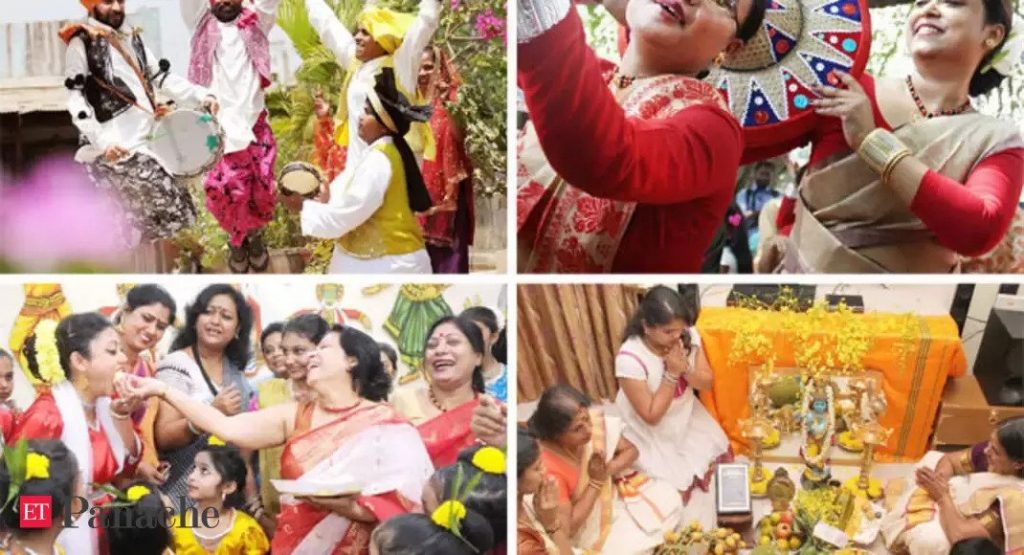Baisakhi, Bihu, Vishu, and more – The Significance of Harvest Festival

The same festival under different names. The significance and traditions of Indian New Year and Harvest Festivals are celebrated by people in various parts of India.
Every year around April 14-15, the Indian people celebrate the same festival under a different name and with different customs. It is the start of the Indian New Year. Also, in some parts, it is the harvest festival that is celebrated to mark happiness after a prosperous harvest. These festivals are called by various names in various parts of the country – Baisakhi, Bihu, Vishu, Poila Boishak & Puthandu. Every year, the festivals fall on April 13, April 14, or April 15, based on the Hindu or Sikh Calendar.
Baisakhi/Vaisakhi
Vaisakhi, also pronounced Baisakhi, marks the first day of the month of Vaisakh. Baisakhi is the harvest festival of Punjab and Northern India. Vaisakhi is also a major Sikh festival as it marks the birth of the Khalsa order by Guru Gobind Singh, the tenth Guru of Sikhism, on April 13th 1699. On this day Gurdwaras are decorated, kirtan processions are held and people take a dip in sacred rivers. They also take part in other festivities and perform a mandatory daan (charity), especially hand fans, water pitchers, and seasonal fruits.
This year Baisakhi is on the 14th of April.
Vishu
Vishu is celebrated by the people of Kerala, and it marks the Malayalam New Year and harvest festival. The festival marks the first day of Medam, the ninth month in the solar calendar in Kerala. It therefore always falls in the middle of April in the Gregorian calendar on 14 or 15 April every year. The traditions of Vishu include the first auspicious view of the festive day (called the Vishukkani), buying new clothes for the occasion, giving money which is the first gift of the year (called Vishukkaineetam), and the feast consisting of food items that taste salty, sweet, sour and bitter (called Sadya).
The ritual arrangement (called Vishukkani) made on this auspicious day in the prayer room of the house includes a list of items that bring prosperity – rice, fruits, vegetables, betel leaves, areca nut, metal mirror, yellow flowers (called kani konna), holy texts and coins. The items are arranged a night before Vishu and are the first sight in the morning along with the statue of Lord Krishna.
This year Vishu falls on the 15th of April.
Bihu
Bohag Bihu is widely celebrated across Assam, and parts of Manipur and Bengal. The Assamese celebrate Bihu thrice a year, which signifies the distinct cycles of farming – Bhogali/Magh Bihu (January), Bohag/Rongali Bihu (April), and Kongali Bihu (October).
On the day of Bohag Bihu, various delicacies like Mangsho, Chira, and Pitha are made. Women, men, and children are seen singing, feasting, exchanging gifts, seeking blessings from elders, wearing new clothes, and performing the traditional Bihu dance on this day.
This year Bihu is celebrated from 14 to 16 April.
Puthandu
Puthandu, also known as Puthuvarudam, Tamil New Year, is the first day of the year on the Tamil calendar and is traditionally celebrated as a festival. It is also celebrated in Tamil-dominated countries Sri Lanka, Malaysia, Singapore, and Mauritius. The celebrations of Puthandu resonate with that of Vishu. The day is observed as family time. Households clean up the house, prepare a tray with fruits, flowers, and auspicious items, light up the family puja altar, and visit their local temples. People wear new clothes and children go to elders to pay their respects and seek their blessings, then the family sits down to a vegetarian feast.
This year Puthandu is on the 14th of April.
Pohela Boishakh
Pohela Boishakh is the first day of the Bengali calendar which is also the official calendar of Bangladesh. This festival is celebrated on 14 April in Bangladesh and 15 April in the Indian states of West Bengal, Tripura, and Assam by Bengalis regardless of religious faith. people thank the divine forces for the harvest of the previous year and that to follow.
People decorate their houses with rangoli in their courtyards made with a paste of rice and water (called alpona). Families get together on this auspicious day and celebrate the new year with Bengali folk songs and dances in traditional attires. Small gatherings are held where children and adults take part in various activities like drawing/painting, dancing, poetry recitation, singing, etc.
So happy and prosperous Indian New Year to all of you and spend some happy times with your family and friends on these happy occasions.
-Staff Reporter








